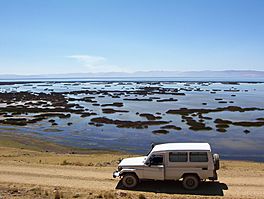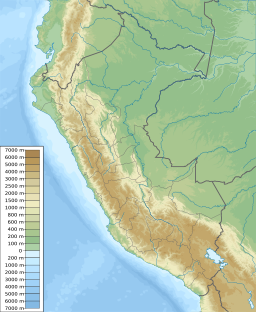Lake Junin facts for kids
Quick facts for kids Lake Junin |
|
|---|---|
| Chinchaycocha | |
 |
|
| Coordinates | 11°01′S 76°07′W / 11.017°S 76.117°W |
| Primary outflows | Upamayu-Mantaro River |
| Basin countries | Peru |
| Surface area | 529.88 km2 (204.59 sq mi) |
| Max. depth | 12 m (39 ft) |
| Surface elevation | 4,082.7 m (13,395 ft) |
Lake Junin (pronounced hoo-NEEN), also called Chinchaycocha, is the largest lake found entirely within Peru. While Lake Titicaca is much bigger, half of it is in Bolivia. This makes Lake Junin special because it's all in Peru. It's also a very important place for watching birds.
Contents
Where is Lake Junin?
Most of Lake Junin is located in the Junín Region of Peru. A small part of its northwestern tip is in the Pasco Region. The lake sits very high up in the mountains. Its surface is about 4,082.7 meters (13,395 feet) above sea level.
The lake is connected to the Mantaro River, which is part of the huge Amazon River system. There's a special power station at the lake's exit. This station helps control the water level using the Upamayo Dam. When there's a lot of rain, the water level stays pretty steady. But during dry years, the water can drop a lot, sometimes 1.5 to 2 meters (5 to 7 feet). This leaves large areas of the lakebed exposed. The deepest part of the lake is about 12 meters (39 feet) deep. This deep spot is about 10 kilometers (6 miles) from a town called Huayre.
Some people believe that the small streams flowing into Lake Junin are the "most distant" starting point of the Amazon River. This is one of the places thought to be the true source of the Amazon.
Protecting the Lake: Pollution Concerns
Since 1933, waste from mining has flowed into Lake Junin. This has harmed the fish and birds in some parts of the lake. Also, dirty water from the towns of Junín and Carhuamayo goes into the lake. These types of pollution make the lake's natural aging process, called eutrophication, happen faster. Eutrophication means the lake gets too many nutrients, which can cause too much plant growth and harm animals.
Amazing Animals and Plants
Lake Junin is home to some very special birds that live nowhere else. These include the critically endangered Junin grebe, which cannot fly. There is also the endangered Junin rail.
Two types of endangered frogs, called Batrachophrynus, also live near the lake. One of them, the Lake Junin giant frog, lives only in the lake itself. Three kinds of small fish called Orestias pupfish are also unique to the lake and nearby waters. Another special fish is the Trichomycterus oroyae catfish.
The lake is surrounded by tall plants that grow out of the water. In some areas, these plants can be as wide as 6 kilometers (4 miles). They can grow so thick that it's impossible to get through them. There are many fish in the lake, but not many different kinds. Some fish, like trout, were brought to the lake by people. These introduced trout have caused problems for the native frogs, making their numbers go down.
See also
 In Spanish: Lago Junín para niños
In Spanish: Lago Junín para niños
- Antaqucha
- Allqaqucha



